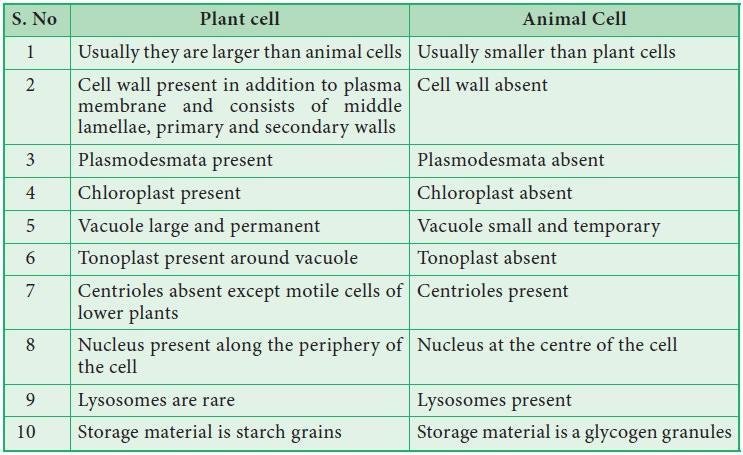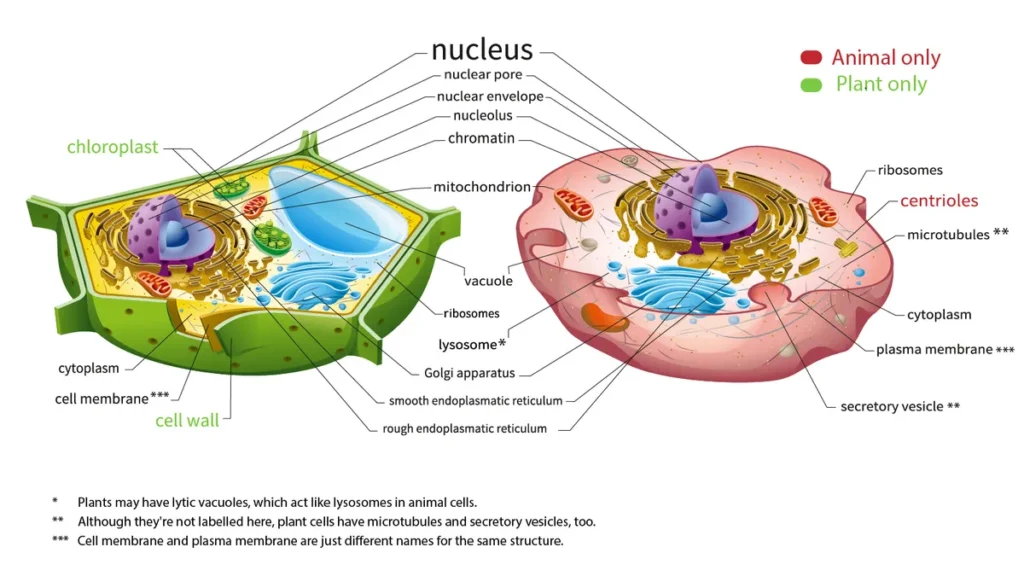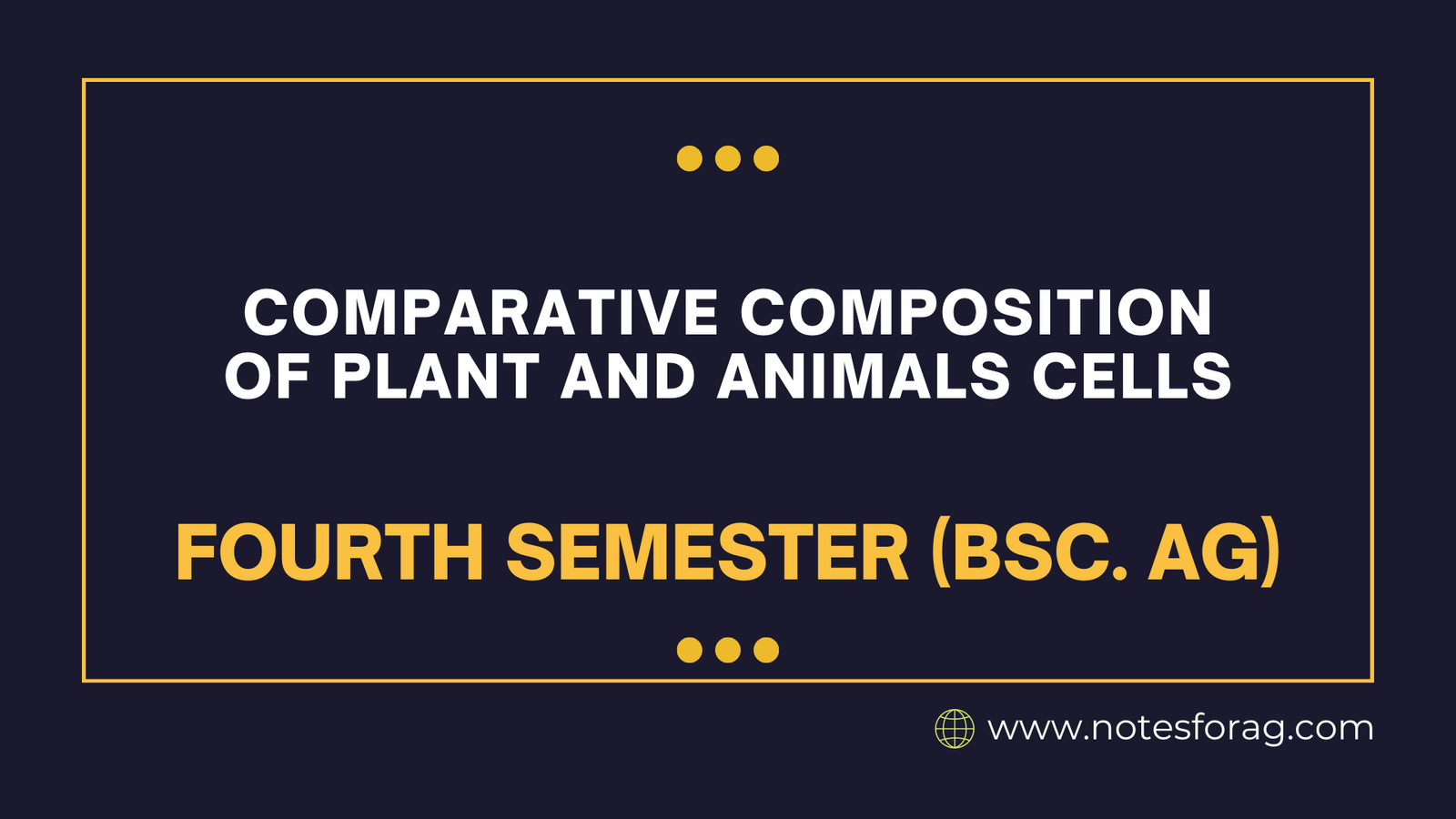Plant and animal cells share many similarities, both being eukaryotic cells with membrane-bound organelles. However, they also have significant differences that reflect their distinct functions and adaptations.
Table of Contents
Here’s a comparison of their cellular and tissue composition:
- Both plant and animals cells have mitochondria, but only plant cells have chloroplasts. Plants don’t get their sugar from eating food, so they need to make sugar from sunlight. This process (photosynthesis) takes place in the chloroplast. Once the sugar is made, it is then broken down by the mitochondria to make energy for the cell. Because animals get sugar from the food they eat, they do not need chloroplasts: just mitochondria.
- Both plant and animals cells have vacuoles. A plant cell contains a large, singular vacuole that is used for storage and maintaining the shape of the cell. In contrast, animal cells have many, smaller vacuoles.
- Plant cells have a cell wall, as well as a cell membrane. In plants, the cell wall surrounds the cell membrane. This gives the plant cell its unique rectangular shape. Animal cells simply have a cell membrane, but no cell wall.
Explanation of Key Differences Between Plant and Animals Cells
- Cell Wall: Plant cells have rigid cell walls composed of cellulose, providing structural support and protection. Animal cells lack this rigid structure, relying on a flexible cell membrane.
- Chloroplasts: Plant cells contain chloroplasts, organelles responsible for photosynthesis, allowing them to produce their own food. Animal cells lack chloroplasts, requiring external sources of energy.
- Vacuoles: Plant cells have a large central vacuole that stores water, nutrients, and waste products, contributing to turgor pressure and cell expansion. Animal cells have smaller, multiple vacuoles with more diverse functions.
- Centrioles: Animal cells have centrioles involved in cell division, while plant cells lack them. Plant cells use microtubule organizing centers instead.
- Storage Molecules: Animal cells store excess energy as glycogen, while plant cells primarily store it as starch.

Tissue Composition of Plant and Animals Cells
- Plant Tissues
- Meristematic tissue: Responsible for growth and development.
- Ground tissue: Provides support, storage, and photosynthesis (parenchyma, collenchyma, sclerenchyma).
- Vascular tissue: Transports water and nutrients (xylem and phloem).
- Dermal tissue: Forms the outer protective layer (epidermis).
- Animal Tissues:
- Epithelial tissue: Covers surfaces and lines cavities.
- Connective tissue: Provides support, protection, and insulation (bone, cartilage, blood).
- Muscle tissue: Allows movement and contraction (skeletal, smooth, cardiac).
- Nervous tissue: Transmits signals throughout the body (neurons).

Key Differences in Tissue Composition
- Plant tissues often have a more rigid structure due to the presence of cell walls, allowing for support and stability.
- Animal tissues are more diverse and specialized, facilitating complex movement, communication, and internal regulation.
Functional Implications of Differences Between Plant and Animals Cells
- Plant cells: Adapted for photosynthesis, structural support, and efficient water management.
- Animal cells: Adapted for movement, complex internal regulation, and rapid communication.
Summary
Animal and plant cells have different cellular and tissue compositions that reflect their different evolutionary adaptations and activities, even though they share many basic eukaryotic traits. Animal cells have centrioles, smaller vacuoles, and a variety of tissue types, whereas plant cells are distinguished by their cell walls, chloroplasts, and enormous vacuoles. These distinctions help explain each animal’s function in the biological world: although plants offer structural support and sustenance, animals move, communicate, and interact with their surroundings in intricate ways.
Frequently Asked Questions (FAQs)
What is the composition of plant and animal cells?
Animal cells each have a centrosome and lysosomes, whereas plant cells do not. Plant cells have a cell wall, chloroplasts and other specialized plastids, and a large central vacuole, whereas animal cells do not.
What is the 5 difference between animal cell and plant cell?
Animal cells, on the other hand, lack cell walls, chloroplasts, and large central vacuoles, but they have lysosomes and centrosomes, which play crucial roles in digestion and cell division, respectively.
What is the composition of plants and animals?
Animals are mainly composed of minerals and protein, whereas plants are predominantly composed of carbohydrates. 2. It outlines the functions and symptoms of nutrient deficiencies and groups nutrients into categories such as water, carbs, proteins, fats, vitamins, and minerals.
Related Articles

